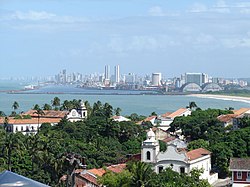Olinda
| Município de Olinda "Primeira Capital Brasileira da Cultura"
Olinda
"Capital Simbólica do Brasil" |
|||
|---|---|---|---|
|
View of the old town of Olinda
|
|||
|
|
|||
| Coordinates | 8 ° 0 '10 " S , 34 ° 53' 28" W | ||
 Location of Olinda in the state of Pernambuco Location of Olinda in the state of Pernambuco
|
|||
| Symbols | |||
|
|||
| Basic data | |||
| Country | Brazil | ||
| State | Pernambuco | ||
| ISO 3166-2 | BR-PE | ||
| Região intermediária | Recife (since 2017) | ||
| Região imediata | Recife (since 2017) | ||
| Mesoregion | Metropolitana do Recife (1989-2017) | ||
| Microregion | Recife (1989-2017) | ||
| Metropolitan area | Recife | ||
| height | 16 m | ||
| Waters | Atlantic | ||
| climate | Am, tropical | ||
| surface | 41.7 km² | ||
| Residents | 377,779 (2010) | ||
| density | 9,063.6 Ew. / km² | ||
| estimate | 391,835 (July 1, 2018) | ||
| Parish code | IBGE : 2609600 | ||
| Post Code | 53000-001 to 53399-999 | ||
| Telephone code | (+55) 81 | ||
| Time zone | UTC −3 | ||
| Website | www.olinda.pe (Brazilian Portuguese) | ||
| politics | |||
| City Prefect | Lupércio Carlos do Nascimento (2017-2020) | ||
| Political party | Solidariedade (SD) | ||
| economy | |||
| GDP | 5,264,034 thousand. R $ 13,515 R $ per capita (2015) |
||
| HDI | 0.735 (2010) | ||
Olinda , officially Município de Olinda (from the Portuguese Ó linda , "O how beautiful") in the state of Pernambuco is one of the oldest cities in Brazil . The jewel of baroque architecture is still a reflection of the European culture of the 17th and 18th centuries and has been a UNESCO World Heritage Site since 1982 .
history
The settlement founded in 1535 by Duarte Coelho Pereira, son of Gonçalo Coelho , was elevated to the status of a city on March 12, 1537. With the settlement of Carmelites (1580), Jesuits (1583), Franciscans (1585) and Benedictines (1586), Olinda steadily gained in importance for the Catholic Church. On July 15, 1614, the Territorial Prelature Pernambuco was established with the administrative seat in Olinda. With the elevation of the prelature to the diocese of Olinda , the city became a bishopric in 1676.
On February 16, 1630, Dutch troops took the city and subsequently conquered the whole of Pernambuco, which became part of Dutch Brazil . In place of Olinda, however, the Dutch chose a nearby trading post because of its strategic location on protected islands as the new administrative center; From this settlement, soon to be called Maurisstad , today's Recife developed .
On November 24, 1631, large parts of Olinda were destroyed by fire.
After Pernambuco was recaptured by the Portuguese in 1654, the administrative center was moved back to Olinda, but over time the city lost its importance more and more in favor of Recife; In 1837 the role as capital was finally lost.
Apart from its beauty, Olinda is one of the cultural centers of Brazil. Olinda is known for its colorful street carnival . The tomb of Hélder Câmara is located in the cathedral of Olinda .
Attractions
- Olinda Cathedral
- Igreja da Misericórdia
- Mosteiro de Sao Bento , minor basilica
- Contemporary Art Museum in the old prison
- Igreja e Mosteiro de Nossa Senhora do Monte of the Missionary Benedictine Sisters
- Museum Mamelungo (Brazil's first doll museum)
Town twinning
- Colonia del Sacramento in Uruguay has been twin town of Olinda since 2013
- Serpa in Portugal has been the twin town of Olinda since 2003
sons and daughters of the town
- Quincas Laranjeiras (1873–1935), guitarist and composer
- Gentil Diniz Barreto (1910–1988), Roman Catholic clergyman, Bishop of Mossoró
- Silvério Jarbas Paulo de Albuquerque OFM (1917–2013), Roman Catholic religious and bishop of Feira de Santana
- Mário Gibson Alves Barboza (1918–2007), diplomat and foreign minister
- Janira Martins Costa (1941–2018), entomologist, university professor and former director of the Brazilian National Museum
- Sílvio Tasso Lasalvia , called “Bita” (1942–1992), football player
- Erasto Vasconcelos (1947–2016), jazz percussionist and composer
- Givanildo Oliveira (* 1948), football player and coach
- Chico Science (1966-1997), musician
- Cléber Santana (1981-2016), football player
Web links
- Entry on the UNESCO World Heritage Center website ( English and French ).
- City Prefecture website , Prefeitura Municipal (Brazilian Portuguese)
- City Council website , Câmara Municipal (Brazilian Portuguese)
- Treasures of the world: Olinda, city of monasteries
Individual evidence
- ↑ Climate Olinda: Weather, average temperature, weather forecast for Olinda. In: climate-data.org. de.climate-data.org, accessed on October 8, 2018 .
- ↑ IBGE : Olinda - Panorama. Retrieved October 8, 2018 (Brazilian Portuguese).
- ↑ IBGE : Estimativas da população residente no Brasil e unidades da federação com data de referência em 1 ° de julho de 2018. (PDF; 2.6 MB) In: ibge.gov.br. 2018, Retrieved October 8, 2018 (Brazilian Portuguese).
- ^ Professor Lupercio 77 (Prefeito). In: com.br. Eleições 2016, accessed October 8, 2018 (Brazilian Portuguese).
- ↑ Luiz Vital Duarte: Transformação de Olinda em monumento nacional . Editora Universitária, Recife 1973.
- ↑ Olinda website , accessed June 14, 2018
- ↑ List of partnerships Serpas , Portuguese Association of District Governments (ANMP), accessed on January 5, 2019





